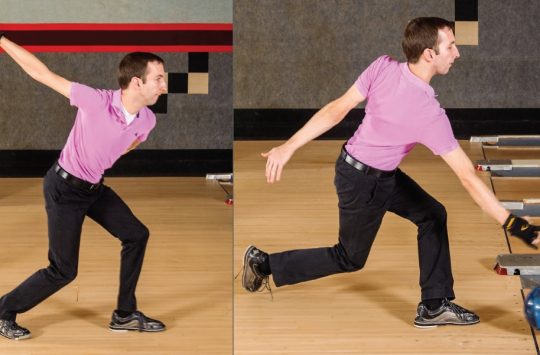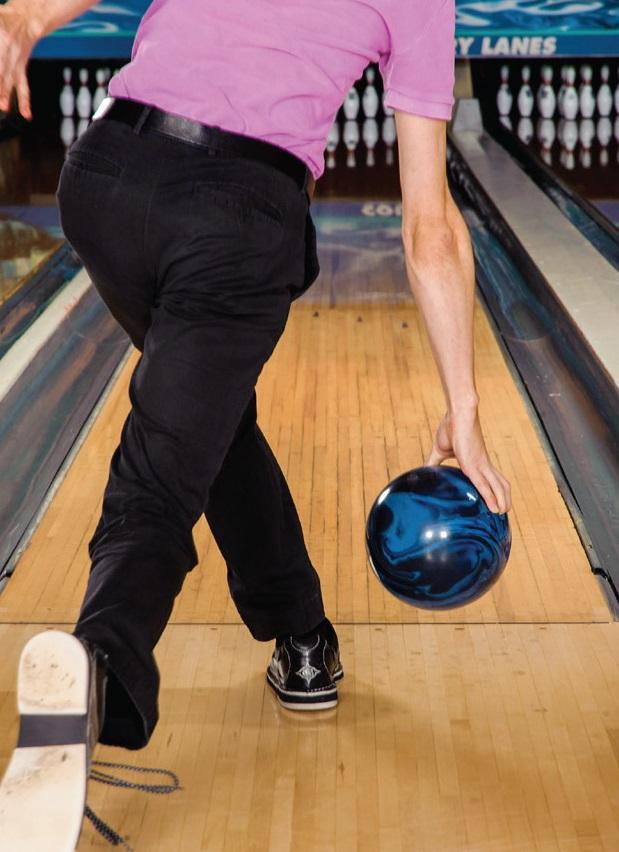How Flawed Timing Impacts Accuracy and What to Do About It

BY MICHELLE MULLEN
When bowlers come in for lessons, it’s common to hear that they are having a hard time hitting their target. Typically, it has nothing to do with a lack of focus. Rather, it has to do with their timing, affecting their leverage at the line.
Sometimes, why you miss is not so obvious. When I took my Bronze-level coaching test, I missed a question. Of course, I argued for my answer.
The question: When a right-handed bowler is late, which way does he miss his target?
My answer was “left.” The answer they were looking for was “right.” This is a great prelude to the topic for this column.
I answered “left” because when I took the test, I had already been coaching for many years. I had seen that when bowlers were late, many made a correction to their timing by pulling the ball in an attempt to get it back in time — therefore, missing their target to the left. But the test was asking which way a bowler misses, not assuming the correction, so the answer was to the “right.” I did not read the assumption into it.
To this day, I see a lot of bowlers miss left when they are late because they then pull the ball, but agree that the ones that do not make the correction to catch up their swing do, in fact, miss right. However, when bowlers miss to the left, it is not always because they are late, but often because they are early.
These days, when bowlers are warming up for their lesson and I see that they have early timing at the line, I’ll take the leap to ask them if they tend to miss their target to the left. Usually, they confirm that they do. Then they continue to explain that they pull the ball all the time. That’s when I have some explaining to do.
So, if a bowler can miss left when they are late because they end up pulling the ball, how is it they can miss left when they are early?
There are two reasons a player can miss left: 1) because they are late and pull, or 2) because they are early and have no leverage to project the ball.
 Late Timing Vs. Early Timing: While lot of bowlers miss left when they are late (left image) because they then pull the ball, those who do not make the correction to catch up their swing do in fact miss right. However, when bowlers miss to the left, it is not always because they are late, but often because they are early (right image).
Late Timing Vs. Early Timing: While lot of bowlers miss left when they are late (left image) because they then pull the ball, those who do not make the correction to catch up their swing do in fact miss right. However, when bowlers miss to the left, it is not always because they are late, but often because they are early (right image).
Let’s go back to a previous column (and a concept that I address early in my book) regarding timing at the finish. Should…
- the ball be there before you?
- you be there before the ball?
- you and the ball be there together?
While many choose C (which was a good answer years ago when equipment was weaker and bowlers generally had to roll the ball more directly to the pocket), the correct answer is B.
But keep in mind that we are talking about split seconds. Although timing does vary among bowlers, based on style, this question alludes to the sequential motion of the body to create power and balance at delivery. Essentially, we get power from the legs up.
I use the analogy of the baseball batter who steps before they swing, or the pitcher who winds up with their lower body before they throw. The body precedes the object it projects for leverage and power. So, in bowling, you want to get the body to the line slightly before the ball — again, especially with today’s stronger equipment as compared to years past when the balls barely hooked. (Back then, you wanted things more “together” at the line.)
So, when a player is early, the ball gets to the line too soon, and this causes the shoulders to close at delivery. When the shoulders close because the ball is ahead of the body, you’ll miss left because your shoulders are no longer open to project the ball, like that of the player in the test question who misses right when they are late because their shoulders are too open at the line.
Furthermore, when you are early at the line and your shoulders are closed — because the ball is there too soon, not because you pulled it — this affects the release and your ability to balance. When your shoulders close up, the hand tends to get around the side of the ball — ironically, much like it does when you pull the ball down.
With early timing, as your shoulders close up, so does your hand. It’s not from pulling; it’s from a poor finish position creating a lack of leverage at the line. And if you are early enough, you literally can’t balance because you have no time to.
I see this issue often, especially with those who have been bowling a long time. While there was a day that earlier timing worked, with today’s equipment you want to be able to project these balls that hook so much more than those of the past because they have much stronger covers and cores.
 Early Timing and Release: With early timing, as your shoulders close up, so does your hand. It’s not from pulling; it’s from a poor finish position creating a lack of leverage at the line.
Early Timing and Release: With early timing, as your shoulders close up, so does your hand. It’s not from pulling; it’s from a poor finish position creating a lack of leverage at the line.
Typically, the fix is to create more swing, giving the body more time to get to the line ahead of the ball. Players who get early usually start the ball too soon. Or they may help the ball back into the swing too quickly and/or do not let it swing behind them enough to get ahead of the ball at the line.
Three common reasons for this are: 1) the ball is too heavy to let it swing through a full arc, 2) the bowler has early timing in the start so the ball is ahead from the beginning, or 3) they do not let the ball swing enough behind them because they are intentionally trying to get the ball to the line too soon. That’s why understanding the desired timing at the line is so important. I go into much more detail on causes of early timing, and how to fix it, in my book.
As I’ve said before, there is definitely a mentality shift required to adjust the timing. If the bowler who was early in the start creates a later start, they will likely just rush the ball to the release point from the top of the backswing because their body wants to get the ball to the line sooner, out of habit. Understanding that you want to be there ahead of the ball is key to being able to relax your downswing as you create later timing in the start.
The ball is heaviest to you when it is farthest from you. To understand this, just take your ball and hold it like a book by your belly. Then, push it away from your body and hold it. It’s much heavier to you when it is away from your center of gravity. So, if your ball is too heavy for you, you will have a hard time pushing it away as well as letting it swing higher behind you. A lighter ball could help.
Also, make sure you have a good ball fit. A poor fit or loose thumb hole will make the ball seem heavier than it is. Furthermore, a poor fit will force you to grip it, which creates tension in your arm and makes it difficult to let it swing.
So, to correct missing left due to the issue of having early timing at the line, create more swing. Create a bigger, more patient arc that affords your body the time to get to the line ahead of the ball. This will give you the projection toward the target that you had been lacking — not because you were pulling, but because your timing was closing up your shoulders.
Michelle Mullen is a USBC Gold-level coach and the author of two books, “Bowling Fundamentals” and “How to Pick Up Spares.” Her instructional column, "Foundation Frame," appears bimonthly in Bowers Journal International. To subscribe now for much more of the industry's best coverage of bowling news and incisive instructional tips and analysis, go here: /bowlers-journal-subscriptions/





